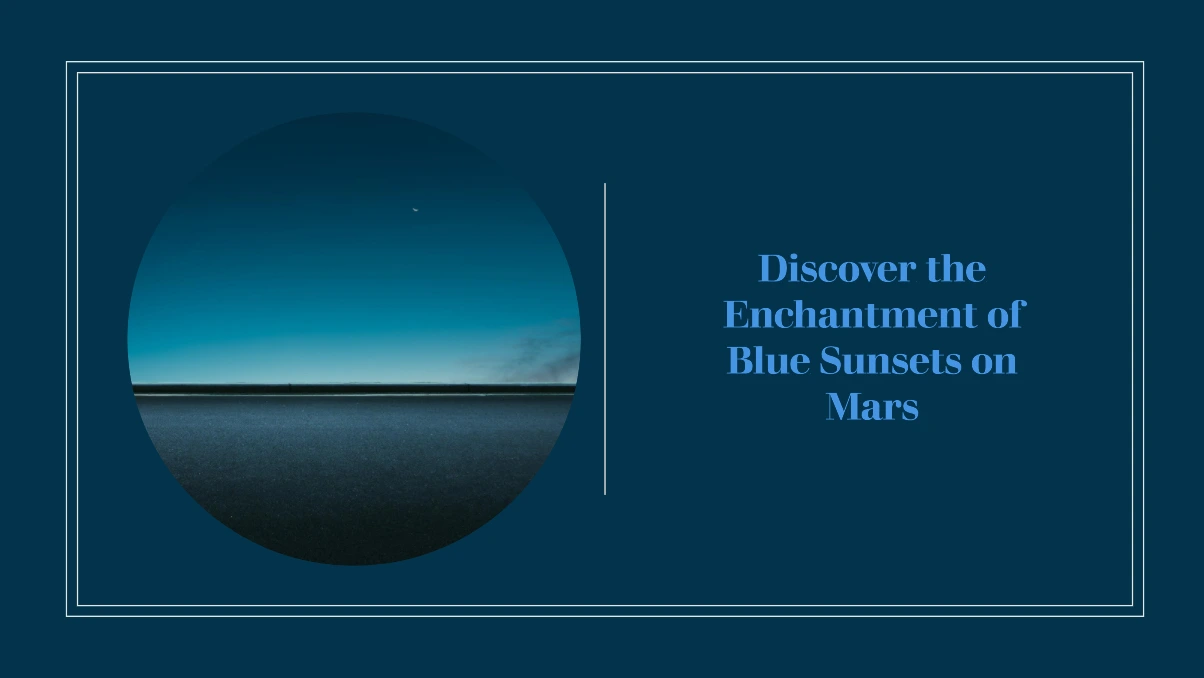Mars, often referred to as the “Red Planet,” is a captivating world that has captured the imaginations of scientists and space enthusiasts alike. While its rusty, reddish surface is its most iconic feature, there’s another celestial spectacle that has been observed on Mars – blue sunsets. In this blog, we’ll dive into the science behind these captivating Martian sunsets, why they appear blue, and what NASA rovers like Mars 2020 Perseverance have discovered about them.
The Martian Atmosphere
Before we delve into the phenomenon of blue sunsets on Mars, let’s take a moment to understand the Martian atmosphere itself.
| Component | Composition (by volume) |
| Carbon Dioxide (CO2) | 95.3% |
| Nitrogen (N2) | 2.7% |
| Argon (Ar) | 1.6% |
| Trace Gases | Water Vapor, Methane, etc. |
Mars has a thin atmosphere composed mainly of carbon dioxide, with only trace amounts of other gases, including water vapor. This composition plays a crucial role in the appearance of Martian sunsets.
The Science Behind Blue Sunsets
Scattering of Light
To understand why sunsets on Mars appear blue, we need to grasp the concept of light scattering. It’s the same principle that causes our own blue skies on Earth.
Light Scattering in Martian Atmosphere
| Wavelength of Light | Scattering Efficiency on Mars |
| Blue (shorter) | High |
| Red (longer) | Low |
As sunlight enters the Martian atmosphere, shorter wavelengths of light, such as blue and violet, scatter more efficiently than longer wavelengths, like red and orange. This scattering effect is responsible for the characteristic blue hue of the Martian sky.
Dust Particles in the Atmosphere
Composition of Martian Dust Particles
| Component | Composition |
| Fine Dust Particles | Mainly iron and silicate dust |
| Larger Dust Particles | Sand-sized grains |
One of the key factors that enhance the blue color of Martian sunsets is the presence of fine dust particles in the atmosphere. These dust particles primarily consist of iron and silicate materials. When sunlight encounters these tiny particles, they scatter shorter blue wavelengths more effectively, intensifying the blue coloration of the sky and sunsets.
NASA’s Exploration of Blue Martian Sunsets
Curiosity Rover’s Discovery
Back in 2015, NASA’s Curiosity rover made a groundbreaking discovery by capturing its first Mars sunset in color. This stunning sequence not only confirmed the blue appearance of Martian sunsets but also shed light on the composition and characteristics of the Martian atmosphere[3].
Key Insights from Curiosity Rover’s Sunset Observation
| Discovery | Implications |
| Martian sunsets exhibit a vivid blue hue | Confirmed the phenomenon |
| The Martian sky is not uniformly red or orange | The atmosphere scatters blue light effectively |
| Dust particles play a crucial role in scattering | Further insight into Martian atmospheric dynamics |
Mars 2020 Perseverance Rover’s Perspective
Mars 2020 Perseverance rover, NASA’s latest Mars mission, has continued the legacy of studying Martian sunsets. Armed with advanced instruments like the Mastcam-Z, it has provided even more insights into this captivating phenomenon.
The Mastcam-Z’s First Martian Sunset
In November 2021, the Mastcam-Z on Perseverance captured its first Martian sunset. This event was a significant milestone in the mission, offering an opportunity to study the Martian atmosphere in unprecedented detail[1].
Key Findings from Mastcam-Z’s First Martian Sunset
| Discovery | Significance |
| Mastcam-Z’s images confirmed the blue sunset hue | Consistency with previous observations |
| Detailed analysis of atmospheric properties | Advancing our understanding of the Martian atmosphere |
| Contribution to ongoing research on Martian climate | Building a comprehensive picture of Mars |
Conclusion
Mars continues to be a source of fascination and discovery for space enthusiasts and scientists around the world. Its blue sunsets, a testament to the interplay of light and the Martian atmosphere, provide not only aesthetic beauty but also valuable insights into the planet’s atmospheric dynamics. Thanks to the dedication and technology of NASA’s rovers, particularly Curiosity and Perseverance, we are uncovering the mysteries of the Red Planet one blue sunset at a time.
As we gaze at these otherworldly sunsets from the perspective of our robotic explorers, we are reminded of the vastness and wonder of the cosmos, and the endless possibilities that lie beyond our own planet.
In this blog, we explored the fascinating world of blue sunsets on Mars, delving into the science behind them, the composition of the Martian atmosphere, and the crucial role played by dust particles. We also highlighted NASA’s Curiosity and Perseverance rovers’ contributions to our understanding of these captivating Martian phenomena. With each new observation, we inch closer to unraveling the mysteries of the Red Planet.
References:
